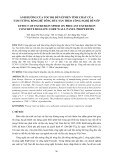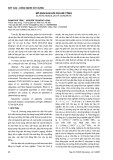
Journal of Science and Transport Technology Vol. 3 No. 2, 34-43
Journal of Science and Transport Technology
Journal homepage: https://jstt.vn/index.php/en
JSTT 2023, 3 (2), 34-43
Published online 30/06/2023
Article info
Type of article:
Original research paper
DOI:
https://doi.org/10.58845/jstt.utt.2
023.en.3.2.34-43
*Corresponding author:
E-mail address:
hoainam.vu@utt.edu.vn
Received: 25/05/2023
Revised: 26/06/2023
Accepted: 28/06/2023
Postbuckling analysis of externally
pressured parabola, sinusoidal and
cylindrical FG-GRCL panels using HSDT
Nguyen Thi Phuong1,2, Cao Van Doan3, Vu Hoai Nam3,*
1Computational Laboratory for Advanced Materials and Structures, Advanced
Institute of Materials Science, Ton Duc Thang University, Ho Chi Minh City
70000, Vietnam, nguyenthiphuong@tdtu.edu.vn
2Faculty of Civil Engineering, Ton Duc Thang University, Ho Chi Minh City
70000, Vietnam
3Faculty of Civil Engineering, University of Transport Technology, Hanoi
10000, Vietnam
Abstract: In the present paper, by using the higher-order shear deformation
theory and the strain-displacement relationships of large deflection, the
postbuckling analysis of the functionally graded graphene-reinforced
composite laminated (FG-GRCL) parabola, sinusoidal, and cylindrical
externally pressured panels is presented in detail. The complex curvature
functions of the parabola and sinusoidal panels are considered. The stress
function is approximately determined and the Galerkin process is utilized to
achieve the stability equations of nonlinear problem. The expression of
pressure-deflection postbuckling behavior can be explicitly obtained. The
influences of curvature types, material properties, and geometric
characteristics on the postbuckling behavior of panels are also considered and
investigated.
Keywords: Postbuckling analysis; Cylindrical panel; Parabola panel;
Sinusoidal panel; Higher-order shear deformation theory.
1. Introduction
Representative structures such as plates and
cylindrical panels are utilized widely in the
mechanical, space, and civil technologies. The
functionally graded graphene-reinforced
composite laminated (FG-GRCL) structures have
attracted many scientists interested in research in
recent years. By using the perturbed method with
two steps and higher-order shear deformation
theory (HSDT), the large-deflection bending,
thermal and mechanical buckling of nonlinear
problem, forced vibration of FG-GRCL cylindrical
panels and plates were analyzed [1-4]. Vibration
and postbuckling of FG-GRCL plates under
thermal loads were calculated utilizing NURBS
formulations [5-7] using the first-order shear
deformation theory [5], and HSDT [6,7]. Nam et al.
[8,9] and Phuong et al. [10,11] used the HSDT,
Galerkin method, and the improved homogeneous
techniques of stiffened structures to investigate the
nonlinear buckling and postbuckling behavior of
FG-GRCL plates and cylindrical panels with FG-
GRCL stiffeners. In the authors’ opinion, no
research exists about external pressured parabola
and sinusoidal FG-GRC panels. Thus, this paper
studies postbuckling analysis of externally






























